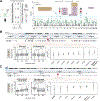Digital phenotyping from wearables using AI characterizes psychiatric disorders and identifies genetic associations
- PMID: 39706190
- PMCID: PMC12278733
- DOI: 10.1016/j.cell.2024.11.012
Digital phenotyping from wearables using AI characterizes psychiatric disorders and identifies genetic associations
Abstract
Psychiatric disorders are influenced by genetic and environmental factors. However, their study is hindered by limitations on precisely characterizing human behavior. New technologies such as wearable sensors show promise in surmounting these limitations in that they measure heterogeneous behavior in a quantitative and unbiased fashion. Here, we analyze wearable and genetic data from the Adolescent Brain Cognitive Development (ABCD) study. Leveraging >250 wearable-derived features as digital phenotypes, we show that an interpretable AI framework can objectively classify adolescents with psychiatric disorders more accurately than previously possible. To relate digital phenotypes to the underlying genetics, we show how they can be employed in univariate and multivariate genome-wide association studies (GWASs). Doing so, we identify 16 significant genetic loci and 37 psychiatric-associated genes, including ELFN1 and ADORA3, demonstrating that continuous, wearable-derived features give greater detection power than traditional case-control GWASs. Overall, we show how wearable technology can help uncover new linkages between behavior and genetics.
Keywords: AI; GWAS; brain; deep learning; digital phenotyping; genetics; genomics; personal health; psychiatry; wearable biosensors.
Copyright © 2024 The Authors. Published by Elsevier Inc. All rights reserved.
Conflict of interest statement
Declaration of interests The authors declare no competing interests.
Figures





Update of
-
Digital phenotyping from wearables using AI characterizes psychiatric disorders and identifies genetic associations.medRxiv [Preprint]. 2024 Oct 18:2024.09.23.24314219. doi: 10.1101/2024.09.23.24314219. medRxiv. 2024. Update in: Cell. 2025 Jan 23;188(2):515-529.e15. doi: 10.1016/j.cell.2024.11.012. PMID: 39399036 Free PMC article. Updated. Preprint.
References
-
- Zablotsky B, Terlizzi EP, and National Center for Health Statistics (U.S.) Mental health treatment among children aged 5–17 years : United States, 2019. NCHS data brief,. - PubMed
-
- UNICEF (2021). Impact of COVID-19 on poor mental health in children and young people ‘tip of the iceberg’ – UNICEF. https://www.unicef.org/philippines/press-releases/impact-covid-19-poor-m....
-
- CDC (2023). Data and Statistics on Children’s Mental Health. https://www.cdc.gov/childrensmentalhealth/data.html.
-
- Hartmann JA, McGorry PD, Destree L, Amminger GP, Chanen AM, Davey CG, Ghieh R, Polari A, Ratheesh A, Yuen HP, and Nelson B. (2020). Pluripotential Risk and Clinical Staging: Theoretical Considerations and Preliminary Data From a Transdiagnostic Risk Identification Approach. Front Psychiatry 11, 553578. 10.3389/fpsyt.2020.553578. - DOI - PMC - PubMed
MeSH terms
Grants and funding
- U24 DA041147/DA/NIDA NIH HHS/United States
- U01 DA051039/DA/NIDA NIH HHS/United States
- U01 DA041120/DA/NIDA NIH HHS/United States
- U01 DA051018/DA/NIDA NIH HHS/United States
- U24 DA041123/DA/NIDA NIH HHS/United States
- U01 DA051038/DA/NIDA NIH HHS/United States
- U01 DA051016/DA/NIDA NIH HHS/United States
- U01 DA041106/DA/NIDA NIH HHS/United States
- U01 DA041117/DA/NIDA NIH HHS/United States
- U01 DA041148/DA/NIDA NIH HHS/United States
- K01 AA025670/AA/NIAAA NIH HHS/United States
- U01 DA041174/DA/NIDA NIH HHS/United States
- K23 AA026890/AA/NIAAA NIH HHS/United States
- U01 DA041093/DA/NIDA NIH HHS/United States
- U01 DA041134/DA/NIDA NIH HHS/United States
- U01 DA041022/DA/NIDA NIH HHS/United States
- U01 DA041156/DA/NIDA NIH HHS/United States
- U01 DA050987/DA/NIDA NIH HHS/United States
- U01 DA051037/DA/NIDA NIH HHS/United States
- R01 AA031959/AA/NIAAA NIH HHS/United States
- U01 DA041025/DA/NIDA NIH HHS/United States
- U01 DA050989/DA/NIDA NIH HHS/United States
- U01 DA041089/DA/NIDA NIH HHS/United States
- U54 AA027989/AA/NIAAA NIH HHS/United States
- U01 DA050988/DA/NIDA NIH HHS/United States
- U01 DA041028/DA/NIDA NIH HHS/United States
- U01 DA041048/DA/NIDA NIH HHS/United States
LinkOut - more resources
Full Text Sources
Medical

